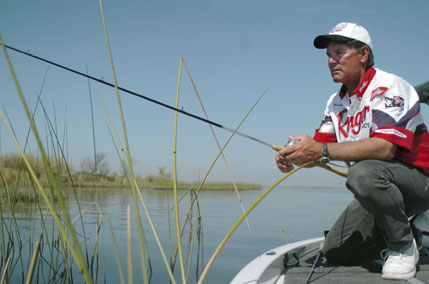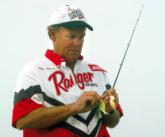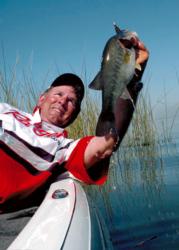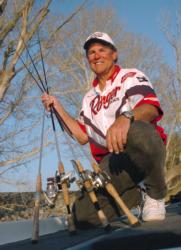Fishing tides
Always figure the tide heights into your game plan

The most logical bass fishing I can think of is tidal fishing. I know it pertains to large waterways like the California Delta, Potomac River, Mobile Delta and dozens more, and for that reason, it seems more difficult because of the vastness of these fisheries. There are, however, some basic things you can do to locate and catch fish.
Looking at tidal water for springtime fishing might be a little easier than at other times of the year. You can generally eliminate deeper boat channels and dredged out marinas. If you don’t have a lot of experience on a certain waterway, taking the deep-water areas off the table eliminates huge amounts of water. Furthermore, bass often relate closely to deeper-water channels or ditches. Therefore, you can further narrow down productive water.
How shallow you need to fish is strictly based on how much tidal movement or how much difference there is between the high and the low tides. Prespawn fish tend to act as they do during the summer and will position themselves based on the available depth of the water. Nesting fish seem to know how much water will cover their nests, and even when the tide gets very low, they never go very far – contrary to what some say. Due to instinct, nesting bass never travel far from the nest.
Delta basics
I’d like to focus on effective spring techniques for the California Delta since I am very familiar with that fishery, but the following tips can be related to most tidal fisheries. Fishing shallow water means a bass never has to travel far to strike a bait. The height of the tide, plus how long the fish are into the spawn, usually tells you what baits to throw. What kind of sun exposure an area gets and the water clarity are also parts of the puzzle.
 Let me talk about these last two things first. The same situation applies at the Delta as it does at a reservoir in the spring. That is, the banks facing south get the most exposure from the sun and tend to warm up first and hold their temperature a little longer.
Let me talk about these last two things first. The same situation applies at the Delta as it does at a reservoir in the spring. That is, the banks facing south get the most exposure from the sun and tend to warm up first and hold their temperature a little longer.
That’s the general rule, but look for exceptions in the places you are fishing.
The Delta topography is all flat, but it doesn’t take shade from a hill or mountain to affect water temperatures. You may be on a south-facing bank or pocket, but a tule berm may be casting a shadow on that bank for several hours a day. Even though the bank should be warmer, it isn’t because of the shade. The part where the sun is being blocked may have fish, but they may not be as active.
I also don’t worry about water clarity – especially muddy conditions – if I believe I am in the right area. After all, don’t we always say, “You never leave fish to find fish?” If you have located an area and storm runoff or large tidal surges turn the water brown, remember that’s a natural condition where there are tide changes twice a day every day of the year. If the fish you are targeting have chosen an area, they are probably not going to leave when a little silt is stirred up.
The only difference is you may have to find a bait or a method that takes into account muddy conditions. Bass may have a harder time finding the bait when the water is murky. Don’t let a change in water clarity affect your confidence in the area. I see guys come up on muddy water, and it takes them off their game. They think it turns the fish off, and pretty soon, they start fishing too fast and think about leaving before they have given the area a chance. Simply change to baits that are designed for stained water – larger-profile, darker-colored lures.
But back to normal conditions. You want to pick methods that match the tidal conditions. On the high tide, you can use a buzzbait or a lipless crankbait to fish over the top of the weeds. The higher the tide, usually the longer there will be some water over the tops of the weeds, and this bite will last a little longer. A lipless crankbait is also a noisy bait and is easy to keep up over the grass on a steady retrieve.
A Speed Trap, even though it has a diving bill, is another bait that gets a lot of use in the Delta. Be forewarned, though: You can’t slap one of these on the water to shake off the grass or you’ll break off the bill. It’s a good bait, but it doesn’t take rough treatment.
Another bait I have a lot of success with is a Johnson Spoon with a U-3 split-tail pork trailer. This bait works really well over the top of the grass, but it’s more versatile than the lipless crankbait or the buzzbait because you can stop the spoon and drop it into holes in the weeds.
The Delta’s most famous bait, the frog, is also a good choice for fishing over holes in the grass. I like them on an outgoing tide, but they seem to work best on the edges between hydrilla and the shore. They just seem better for me on the lowering tide.
Of course, you should still have a pitching bait ready when the tide is high. There will be some specific places where you have to pitch a bait, even when the water is up. But you have to make some adjustments as the tide goes out. The first adjustment you should make starts when you are prefishing during the time when the bass are spawning. That is, you want to locate beds that have water on them even at low tide. You should always figure the tide heights into your game plan.
 At high tide, the females are out roaming around or near one of the holes in the grass. But as the tide drops, the bucks stay in the holes in the grass, and the females go out into deeper water or away into the nearest heavier cover. That deeper water only needs to be 1 or 2 feet deeper, such as a little depression.
At high tide, the females are out roaming around or near one of the holes in the grass. But as the tide drops, the bucks stay in the holes in the grass, and the females go out into deeper water or away into the nearest heavier cover. That deeper water only needs to be 1 or 2 feet deeper, such as a little depression.
I’m convinced these females don’t go very far. In my experience, they go out of sight for a time as the tide goes out, but as soon as it starts back up, they can be seen again in the same places. They couldn’t have been very far away.
During the low tide, then, I fish the heavier cover on the deep side. It’s a secure area for the bigger fish, but one where they can get back to the nest with the next turn of the tide.
For this kind of fishing, I have several bait choices. It’s pretty hard not to have a Senko or a jig tied on. In the last Delta tournament I fished, I caught an 11-pounder that was on the deeper side of the cover and burrowed in tight.
I also like a 6-inch lizard in green with red flake, June bug or pumpkin colors and the 5-inch Gulp! Wacky Crawler. I fish both on 15-pound-test Vanish.
Last thought
Even though the Delta has lots of cover and good water clarity, the fish are shallow and get a lot of pressure. When the tide is down, you don’t want to run the trolling motor if possible. I use a push pole or make long casts, or I drift down grass lines. The bigger females are very sensitive.
